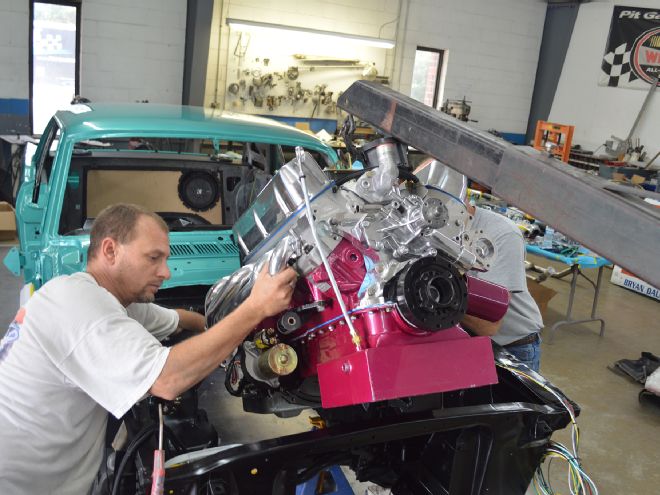
Last month, we introduced you to Project Road Warrior, Courtney Barber’s 1965 Mustang hardtop. A veteran of many road rallies and tours over the last few years, Barber’s pony had been rode hard and put away wet enough times that it was ready for a complete overhaul, both cosmetically and mechanically. The first step, which we addressed last month, was the significant rust repair, panel replacement, and new paint to make the car visually nicer and physically more capable. Now it’s time to address the drivetrain.
Courtney and the Mustang make up Team Mustang Girls (https://www.facebook.com/TeamMustangGirls), and one of the biggest problems they had on the rallies was keeping up with the other cars, specifically the exotics on Bullrun (which includes Lamborghinis, Porsches, and other high-dollar, speedy rides owned by the venture capital crowd) and the pro-built hot rods on the Goodguys Road Tour. Our Road Warrior’s carbureted 351W junkyard engine ran fine, but didn’t make the steam necessary to run with the big dogs, and the C6 automatic’s lack of overdrive meant that when she did try to keep up, the tach needle was situated on the north side of 3,500 rpm—not the greatest for engine longevity or Barber’s nerves.
The fix? A new crate motor from Ford Performance for the power part of the equation, and a 4R70W four-speed automatic transmission, with overdrive of course, from Performance Automatic to allow decent highway speed. While the car was at paint, Kevin Kelly at Mojo Performance in Concord, North Carolina, set about taking an inventory of all the parts in hand and then mating the engine and transmission together prior to dropping the assembly into the car.
We were on a rushed schedule in an effort to make it to the Hot Rod Power Tour, which sadly we missed. If you’ve ever built a project car yourself, then you’re intimately aware of how it always takes twice as long as you thought and costs three times as much as originally budgeted. And that’s in a best-case scenario. As we write this, the car is finished and back doing its thing on the highways and byways of America, but you’ll have to wait to see that. For now, check out what was involved in re-powering Project Road Warrior.
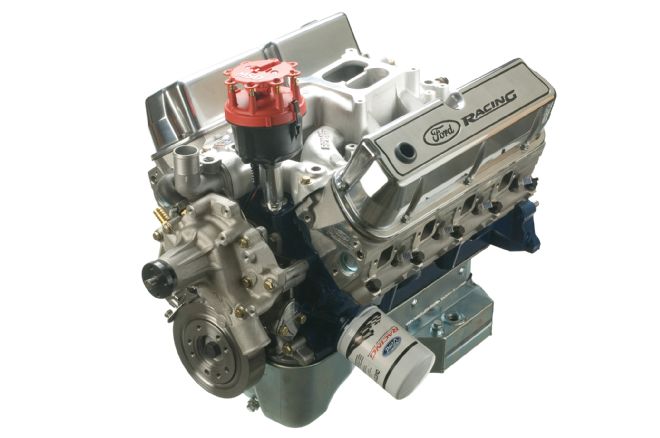
The Engine
When we told our buddies at Ford Performance what we were doing with the car, they chose an engine that we didn’t even know about: the S347JR. This is a sealed engine that is approved for use in the American Canadian Tour (ACT) Late Model series, a circle track racing series that requires a sealed crate engine. It wouldn’t have been our first choice for obvious reasons, but then we started looking at the parts and quickly came around to Ford’s line of thinking.
PN M-6007-S347JR has a displacement of 347 ci (4.030-inch bore, 3.400-inch stroke) and it uses a Boss 302 race block, Scat forged crank and rods, Mahle pistons with floating pins, and a COMP Cams 35-410-8 hydraulic roller camshaft with 0.533-inch lift intake and exhaust and 206 degrees duration (at 0.050-inch) on both intake and exhaust sides. The cylinder heads are Ford Racing’s aluminum “X” heads (M-6049-X307) with 1.94-inch intake valves and 1.54-inch exhaust valves, beehive valvesprings, and 1.60:1 roller rockers. The intake is an Edelbrock Performer RPM Air-Gap dual-plane, which has consistently been proven to be one of the best street performance intake manifolds you can bolt onto a small-block Ford. Also included is an Edelbrock water pump, MSD billet distributor, SFI-approved damper, and ARP head studs. Compression is 10.5:1 (which is about as high as you’d want it in a car that has to run on pump gas), and the output is 350hp at 5,500 rpm and 400 lb-ft at 4,000 rpm, though that was with the circle track–required 500-cfm two-barrel carburetor and we’re going to run a four-barrel Holley Terminator EFI throttle body (which you’ll read more about in a later issue).
After looking at the specs, especially the cam specs, we’re confident that this is going to be a perfect engine for our needs. There were a few things we needed to change before it went in the car, however. The first was the distributor gear. The included MSD distributor came with a bronze drive gear. That’s fine with a race engine that gets torn down and inspected frequently (like this crate engine was originally intended), but a bronze gear wears far too quickly for a street car that will see real road miles. For that reason, we changed it for a COMP Cams mellonite gear that mates perfectly with the cam and will last a long time. The other change was swapping the rear sump oil pan for a front sump pan that fits the early Mustang chassis.
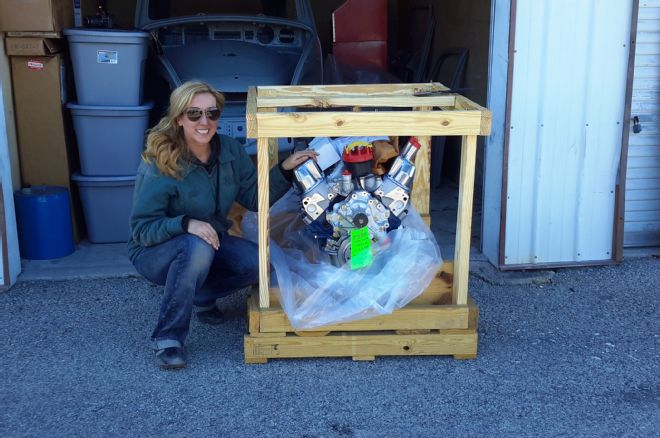 Barber was like a little kid on Christmas morning when the Ford Performance engine was delivered.
Barber was like a little kid on Christmas morning when the Ford Performance engine was delivered.
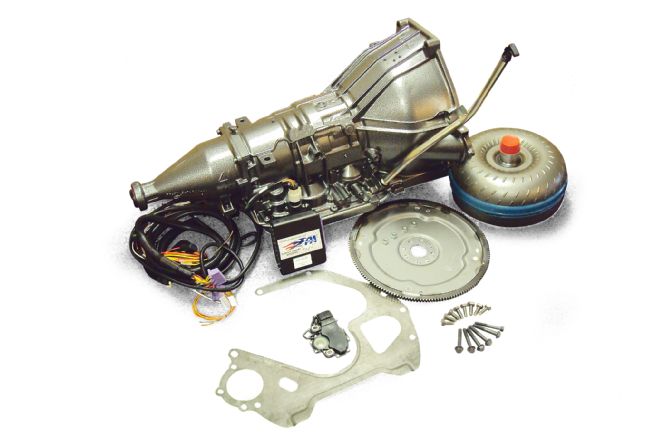
The Transmission
At first, we thought about swapping the C6 automatic for a five- or six-speed manual, but saner heads prevailed and we decided to stay with the auto, and Performance Automatic (PA) obliged us with their 4R70W Street Smart System. The 4R70W Street Smart Packages come complete with PA’s Street Smart 4R70W transmission, the Smart Shift stand-alone transmission controller that’s user friendly and does not require a laptop to tune, a custom torque converter, dipstick/filler tube, complete transmission wiring harness, block plate, flexplate, flexplate bolts, bellhousing bolts, and torque converter nuts. PA says these Street Smart Systems will handle 650 hp and come with Performance Automatic’s lifetime warranty.
The 4R70W is essentially the modern iteration of the venerable Ford AODE electronic overdrive automatic that was released in 1992, and was used in 1996-2004 V-6 Mustangs, F-series trucks, and a bunch of other Ford vehicles. Its overdriven Fourth gear has a 0.70:1 ratio, which, when combined with the 3.08:1 gears in the car’s 9-inch rear, will allow us to cruise at 70 mph with the engine not far above idle—perfect.
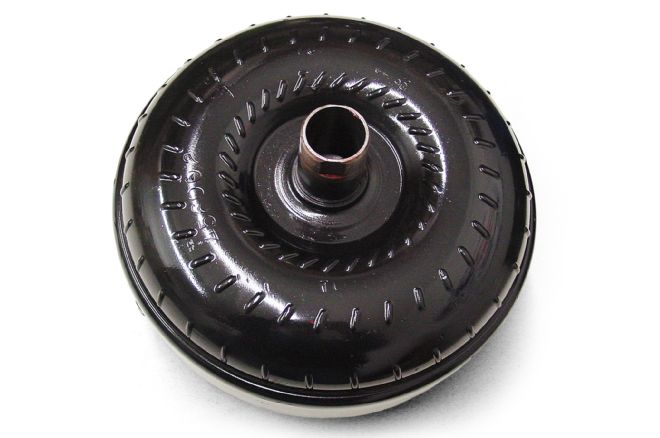 The torque converter that PA spec’d for us is a 12-inch unit that should stall at 2,400 rpm and includes a factory-style lockup feature that lessens highway rpm even more, therefore improving mileage.
The torque converter that PA spec’d for us is a 12-inch unit that should stall at 2,400 rpm and includes a factory-style lockup feature that lessens highway rpm even more, therefore improving mileage.
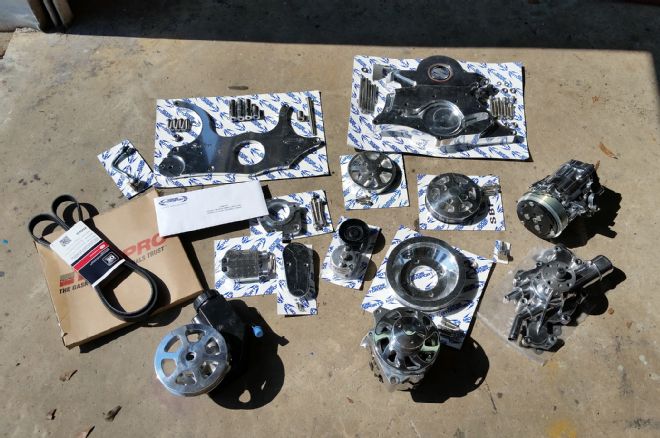
The 4R70W is an electronically controlled transmission and requires this included MSD Transmission Control Unit in order to work. No longer do you have to pull the pan and deal with valvebody check balls and springs to change the shift characteristics, the MSD controller allows you to control shift points and firmness under all sorts of loads. You can make it shift butter-smooth at light throttle like when pulling away from a stoplight, or bang the U-joints out of the car under full throttle, and everything in-between. It’s really slick.
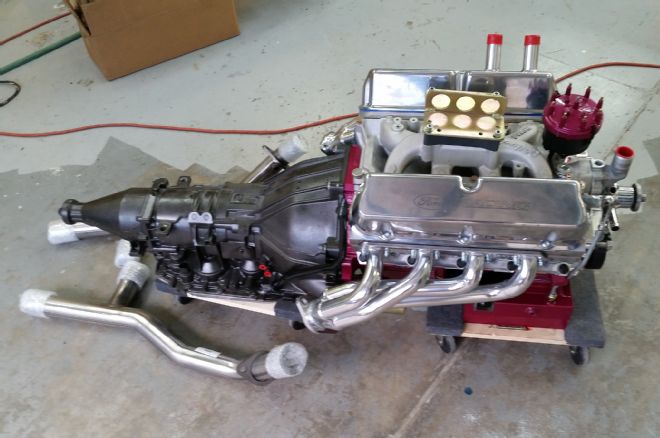
While the Mustang was at the paint shop, Kevin Kelly at Mojo Performance joined the engine and transmission together to drop into the car as a unit. The PA flexplate was torqued to the crankshaft with new Ford fasteners, and the engine and transmission were mated together and held with new fasteners. Next the JBA headers were installed, and this is where the first issue with the “ears” on the transmission arose. The 4R70W has four locating ears that are cast into the case and used for machining purposes during manufacturing. On the left side of the case, the upper ear was directly in the way of the header collector—after removal of this ear the header fit with ample clearance.
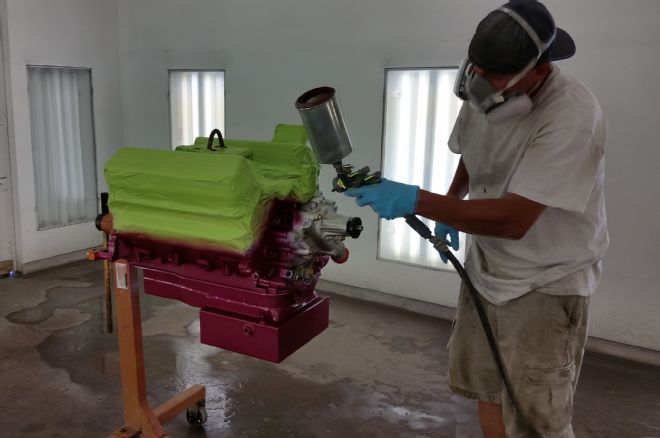 It’s a girl’s car and magenta is her favorite color, so Barber masked the engine and Mahan sprayed the short-block magenta in Stono's paint booth. The MSD box and oil filter got the same paintjob.
It’s a girl’s car and magenta is her favorite color, so Barber masked the engine and Mahan sprayed the short-block magenta in Stono's paint booth. The MSD box and oil filter got the same paintjob.
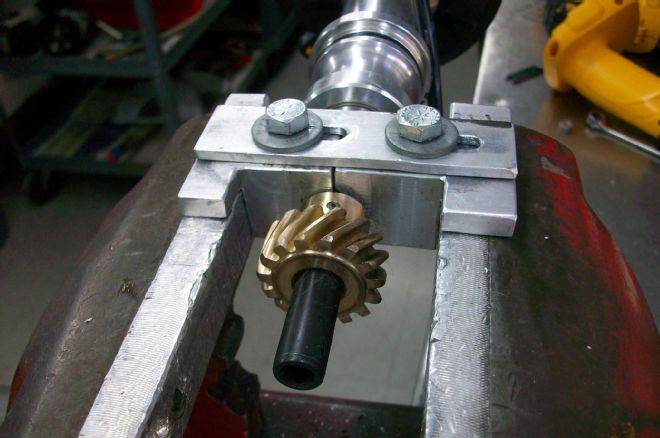
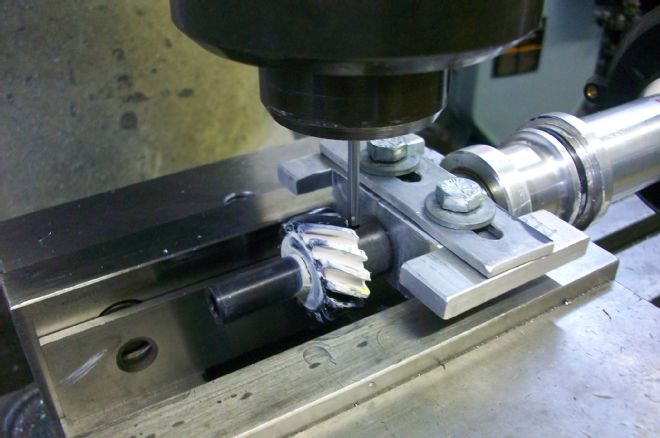
While preferred for racing applications were there are frequent inspections for wear, a bronze distributor gear is unsatisfactory for extended mileage use on a street car. So the bronze gear that came with the engine was replaced with the correct steel gear from COMP Cams.

When the 351W was first installed in the car, Barber fabricated her own accessory drive brackets. While they were fully functional, they weren’t all that good looking, so we replaced them with a full serpentine setup from Eddie Motorsports. PN MS107-63 includes a new Ford Racing water pump, Sanden AC compressor, Maval power steering pump, and Powermaster 140-amp one-wire alternator. The kit also comes with a billet aluminum timing cover with built-in mounting points for all of the accessories. We got ours polished, but you can get it with a natural cast finish as well.
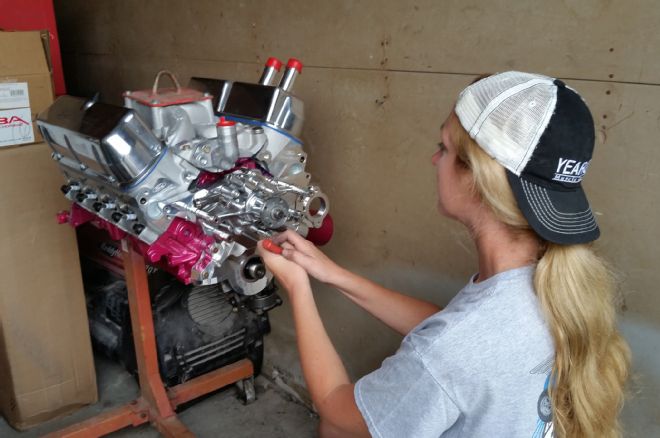
The Eddie front drive brackets and accessories were installed before the engine went in the car, because it’s easier to do it on an engine stand than it is leaning over freshly painted fenders.
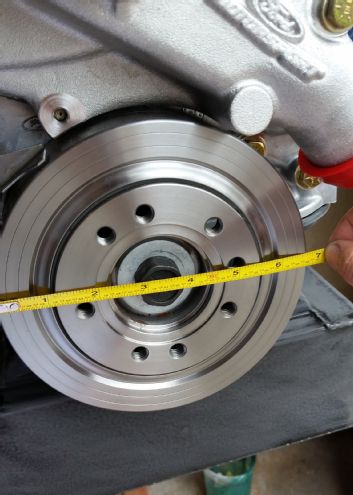
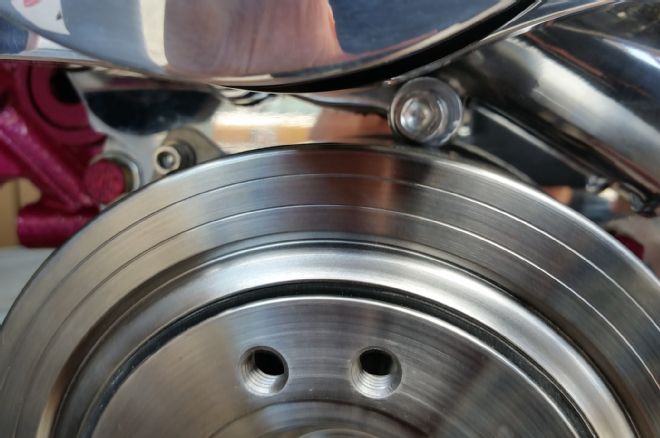
Fortunately, Pioneer manufactures an SFI unit of the correct dimensions, and that’s what was chosen for this project, and provided by Summit Racing.
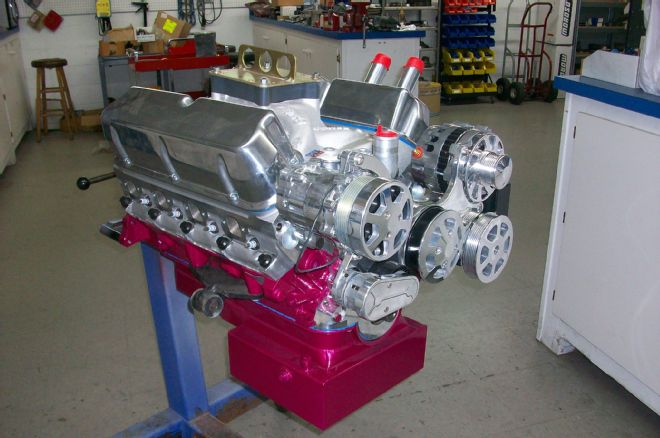
We had to use some 0.125-inch shims to get the alternator and power steering pump aligned correctly. The Eddie Motorsports kit looks sharp!
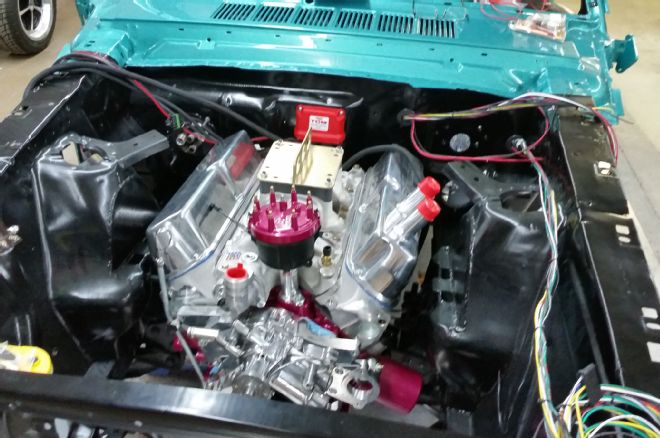
When the car got back from the paint shop, we dropped the engine and trans into place. As you can see, we left the Eddie brackets in place but removed the actual accessories to make installation easier. You can also see the beginning of the re-wiring process using a Painless Performance Products wiring harness.
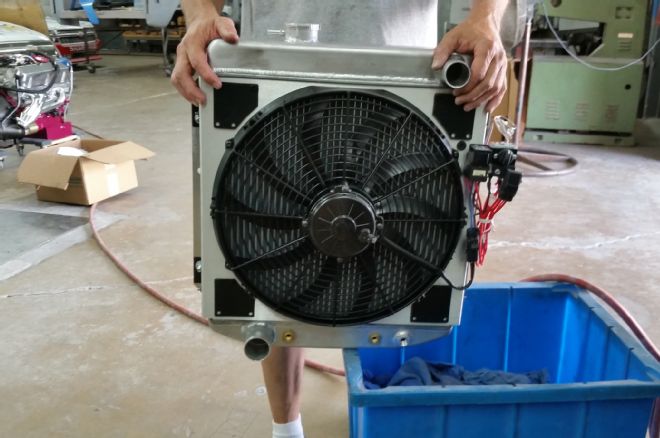
To keep our Ford Performance engine cool, we used the same radiator and electric fan from Old Air Products that was in the car previously. Old Air also supplied the air conditioning in a previous build.
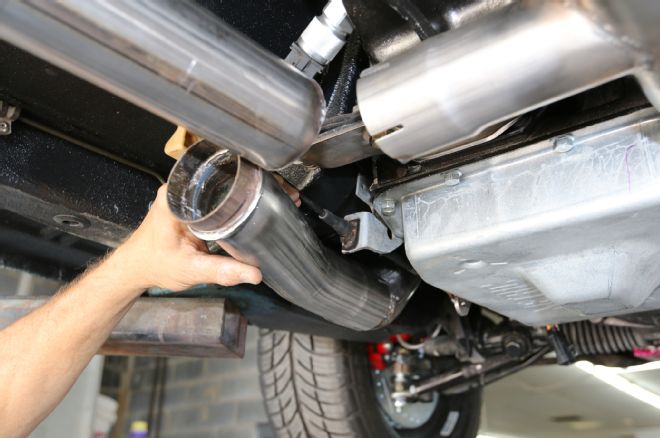
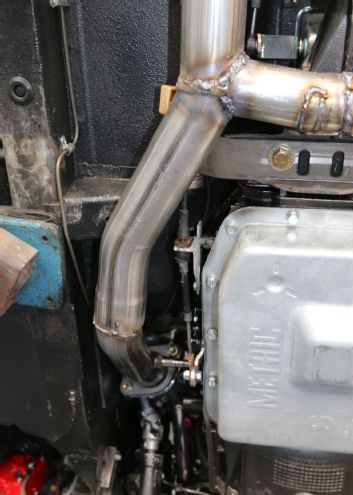
The JBA exhaust system fit better than any other aftermarket muscle car full exhaust systems we’ve ever worked with, but it was designed around a C4 transmission or four-speed manual, not the much larger 4R70W we put in the car. As Kevin Kelly said, “Early Mustangs, especially 1965-1966 models, have very small and narrow transmission tunnels and the lower right ear on the trans hit firmly against the tunnel during installation, so that ear had to be removed as well. Second, the mounting pad on the tailshaft housing is both lower and farther to the rear, making fabrication of a transmission crossmember difficult. I used a mount designed for a racing application. Also, the crossover tube on the JBA H-pipe is very close to the mount, increasing the difficulty in this area. The next area to address was the shift arm—a rod cannot be used to actuate the shift arm due to clearance and location. My solution was to use the cable and shift arm from a 1999-2004 Mustang 3.8L V-6 that used a 4R70W stock. While this approach solved the shift mechanism issues, the JBA H-pipe’s driver’s side down tube was bent to run right where the shift cable bracket mounts on the 4R70W. The JBA kit fit the vehicle itself perfectly and was of excellent quality, however it appears that a 4R70W was not checked for fit during development. The solution was to move the downpipe over using two 45-degree bends. This worked very well and fit perfectly allowing more that enough clearance.”
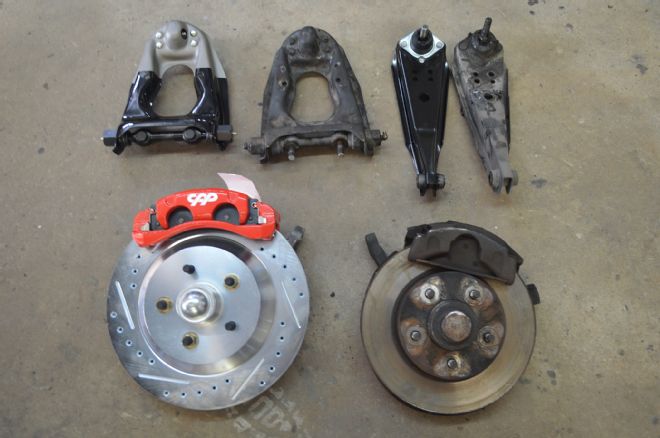
The Brakes
Several years ago, Courtney swapped the stock drum brakes for Granada discs, which she scrounged from a junkyard. They worked to stop the car but didn’t give the driver a lot of confidence in panic stop situations, so we turned to Classic Performance Products for their Mustang complete power front brake kit (PN 6567FBP-P), which includes everything needed to swap out front drum brakes for OE-type front disc brakes originally available on 1968-1973 Mustangs. They are technically correct for 1970-1973 Mustangs as well, but the 1968-1969 OE differed only in that their spindles have a smaller pin. This kit uses the larger “Boss”-type pin used after 1969 and the CPP spindles use the Granada-spec outer tire rod hole. CPP also supplied a rear disc brake kit to replace the drums on our 9-inch rearend.
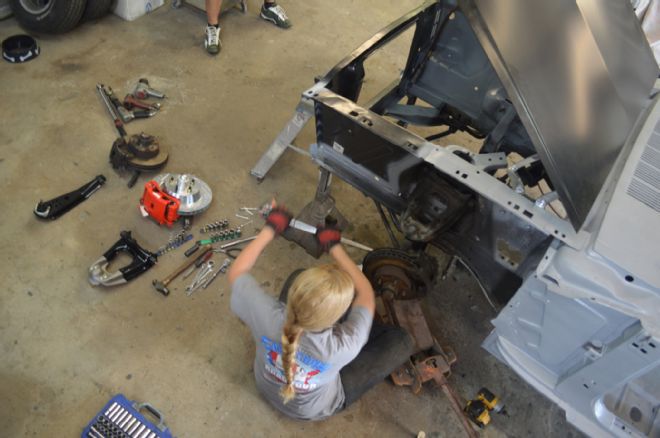
The installation of the brakes actually happened before the car went to paint. The grungy control arms were replaced with new arms from Scott Drake.
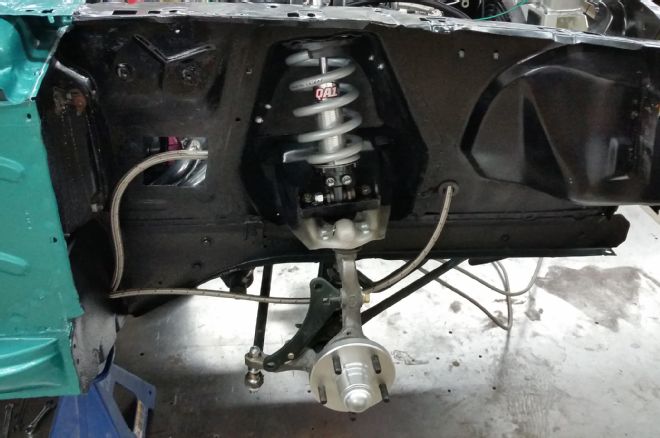
Also leftover from the previous build were the Speed Direct bolt-on coilovers and rack-and-pinion steering upgrade. These worked so well that Barber left them alone.
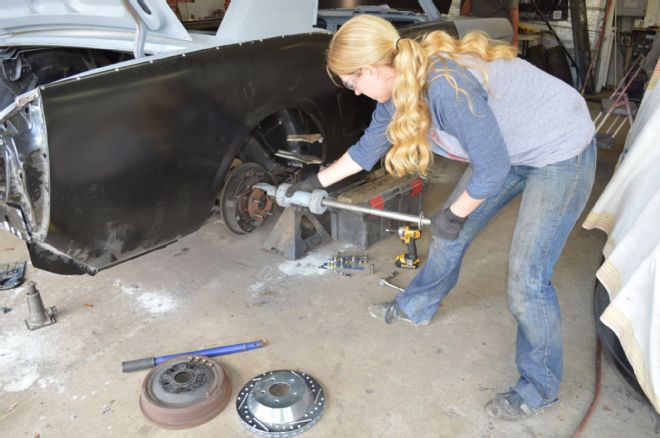
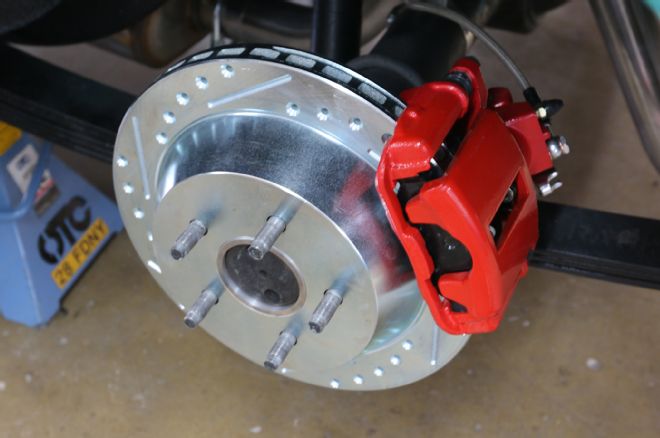
CPP also supplied a set of rear disc brakes to replace the stock drums. The Mustang has a Ford 9-inch rearend Barber found (again) in a junkyard.
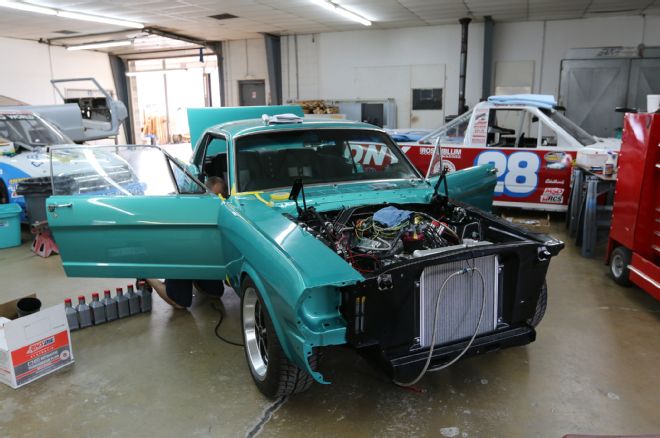
This is how we leave Project Road Warrior for this month, in the shop at Mojo Performance. Still left to do is install the Holley Terminator electronic fuel injection system and tune it, tune the Performance Automatic transmission with the MSD controller, wire the entire car … and about a zillion other small details, as with any complete build.